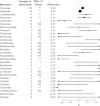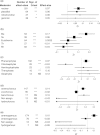Large-scale longitudinal gradients of genetic diversity: a meta-analysis across six phyla in the Mediterranean basin
- PMID: 23145344
- PMCID: PMC3492785
- DOI: 10.1002/ece3.350
Large-scale longitudinal gradients of genetic diversity: a meta-analysis across six phyla in the Mediterranean basin
Abstract
Biodiversity is the diversity of life at all scales, from genes to ecosystems. Predicting its patterns of variation across the globe is a fundamental issue in ecology and evolution. Diversity within species, that is, genetic diversity, is of prime importance for understanding past and present evolutionary patterns, and highlighting areas where conservation might be a priority. Using published data on the genetic diversity of species whose populations occur in the Mediterranean basin, we calculated a coefficient of correlation between within-population genetic diversity indices and longitude. Using a meta-analysis framework, we estimated the role of biological, ecological, biogeographic, and marker type factors on the strength and magnitude of this correlation in six phylla. Overall, genetic diversity increases from west to east in the Mediterranean basin. This correlation is significant for both animals and plants, but is not uniformly expressed for all groups. It is stronger in the southern than in the northern Mediterranean, in true Mediterranean plants than in plants found at higher elevations, in trees than in other plants, and in bi-parentally and paternally than in maternally inherited DNA makers. Overall, this correlation between genetic diversity and longitude, and its patterns across biological and ecological traits, suggests the role of two non-mutually exclusive major processes that shaped the genetic diversity in the Mediterranean during and after the cold periods of the Pleistocene: east-west recolonization during the Holocene and population size contraction under local Last Glacial Maximum climate in resident western and low elevation Mediterranean populations.
Keywords: Arthropod; Bryophyte; Chordata; Holocene; Mollusc; Pleistocene; Pteridophyte; Spermaphyte; biodiversity; biogeography; genetic diversity; longitude; meta-analysis; past climate; phylogeography; recolonization.
Figures




References
-
- Aloe AM, Becker BJ. Teacher verbal ability and school outcomes: where is the evidence? Educ. Res. 2009;38:612–624.
-
- Van Andel TH. The climate and landscape of middle part of Weichselian glaciation in Europe: the stage 3 project. Quatern. Res. 2002;57:2–8.
-
- Aravanopoulos FA, Panetsos KP, Skaltsoyiannes A. Genetic structure of Pinus brutia stands exposed to wild fires. Plant Ecol. 2004;171:175–183.
-
- Atkinson RJ, Rokas A, Stone GN. Longitudinal patterns in species richness and genetic diversity in European oaks and oak gallwasps. In: Weiss S, Ferrand N, editors. Phylogeography of southern European refugia. Dordrecht, The Netherlands: Springer; 2007. pp. 127–151.
-
- Avise JC. Phylogeography: the history and formation of species. Cambridge, MA, USA: Harvard University Press; 2000. p. 447.
LinkOut - more resources
Full Text Sources
Miscellaneous

